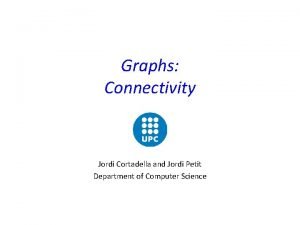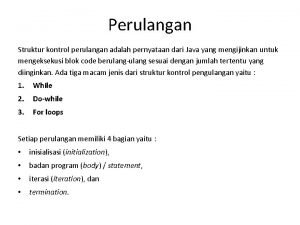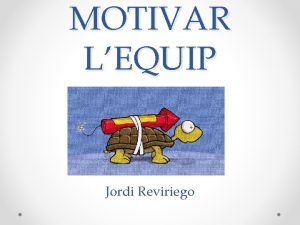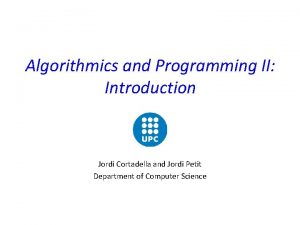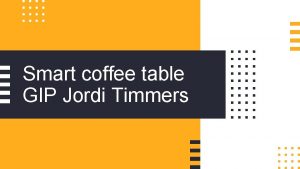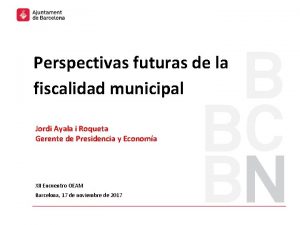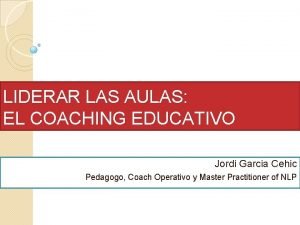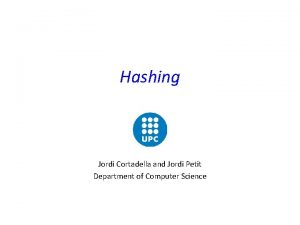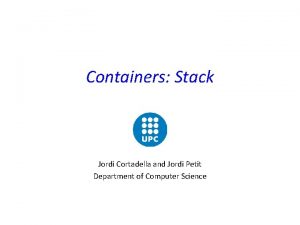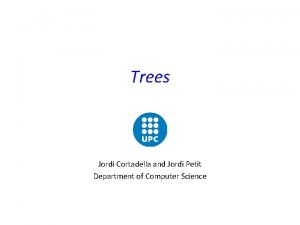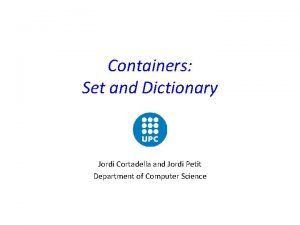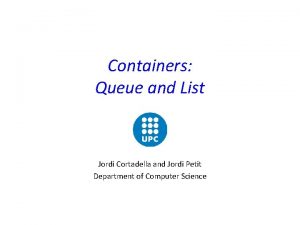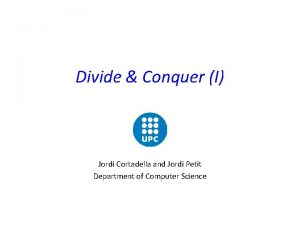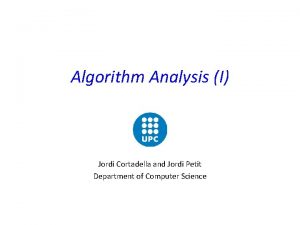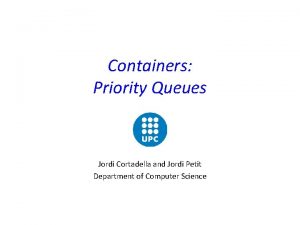Conditional and iterative statements Jordi Cortadella Department of














- Slides: 14

Conditional and iterative statements Jordi Cortadella Department of Computer Science

Maximum of two numbers • Write a program that reads two numbers and prints the maximum value of both. • Example: – The maximum of 20 and 38 is 38. – The maximum of -3 and -8 is -3. Introduction to Programming © Dept. CS, UPC 2

Maximum of two numbers #include <iostream> using namespace std; // This program reads two numbers and // prints the maximum value of both int main() { int x, y; Conditional cin >> x >> y; statement int m; if (x > y) m = x; else m = y; cout << "The maximum value is " << m << endl; } Introduction to Programming © Dept. CS, UPC 3

Maximum of two numbers #include <iostream> using namespace std; cin // This program reads two numbers and // prints the maximum value of both int main() { int x, y; cin >> x >> y; int m; if (x > y) m = x; else m = y; cout << "The maximum value is " << m << endl; } Introduction to Programming © Dept. CS, UPC x 3 m 8 y 8 x > y? true false m = x m = y 4

Maximum of two numbers (II) #include <iostream> using namespace std; // This program reads two numbers and // prints the maximum value of both int main() { int x, y; cin >> x >> y; cout << "The maximum value is "; if (x > y) cout << x; else cout << y; cout << endl; } Introduction to Programming © Dept. CS, UPC 5

Maximum of two numbers (III) #include <iostream> using namespace std; // This program reads two numbers and // prints the maximum value of both int main() { int x, y; cin >> x >> y; if (x < y) x = y; cout << x << endl; } Introduction to Programming © Dept. CS, UPC x < y? true false x = y 6

Repetitive statements • Assume the following specification: Input: reads a number n > 0 Output: prints the sequence 1 2 3 … n (one number per line) • This specification suggests some algorithm with a repetitive procedure. Introduction to Programming © Dept. CS, UPC 7

Print the numbers 1. . N > print_numbers 8 1 2 3 4 5 6 7 8 > Introduction to Programming © Dept. CS, UPC 8

Print the numbers 1…N // Input: reads a number n > 0 // Output: prints the numbers 1. . . n (one per line) int main() { int n; cin >> n; cout << 1 << endl; cout << 2 << endl; cout << 3 << endl; cout << 4 << endl; How many? cout << n << endl; } Introduction to Programming © Dept. CS, UPC 9

Print the numbers 1…N // Input: reads a number n > 0 // Output: prints the numbers 1. . . n (one per line) int main() { int n; n 5 cin >> n; int i = 1; i i <= n while (i <= n) { 1 true cout << i << endl; 2 true i = i + 1; 3 true } 4 true } 5 true Loop body cout << 1 << endl; i = 1 + 1; cout << 2 << endl; i = 2 + 1; cout << 3 << endl; i = 3 + 1; cout << 4 << endl; i = 4 + 1; cout << 5 << endl; i = 5 + 1; 6 false Introduction to Programming © Dept. CS, UPC 10

The while statement • Syntax: while ( condition ) statement; (the condition must return true or false) • Semantics: – Similar to the repetition of an if statement – The condition is evaluated: • If true, the statement is executed and the control returns to the while statement again. • If false, the while statement terminates. Introduction to Programming © Dept. CS, UPC 11

Multiplication table • Write a program that reads a number n (between 1 and 9) and prints the multiplication table of n: • Example for n = 6: 6 6 6 6 6 Introduction to Programming x x x x x 1 2 3 4 5 6 7 8 9 = = = = = 6 12 18 24 30 36 42 48 54 © Dept. CS, UPC 12

Multiplication table // Input: reads a number 0 < n < 10 // Output: prints the multiplication table of n int main() { int n; cin >> n; int i = 1; while (i <= 9) { // or also (i < 10) // print n x i = n i cout << n << " x " << i << " = " << n i << endl; i = i + 1; } } Introduction to Programming © Dept. CS, UPC 13

Summary • Conditional statements (if-else) are used to take decisions that depend on values of variables. • The while statement is the fundamental instruction to iterate under a condition that determines termination. • The control of conditional and loop statements is determined by Boolean expressions. Introduction to Programming © Dept. CS, UPC 14
 Strongly connected components
Strongly connected components Both conditional statements and iterative statement
Both conditional statements and iterative statement Perulangan bersarang java
Perulangan bersarang java Iterative statements
Iterative statements Jordi reviriego
Jordi reviriego Jordi ustrell
Jordi ustrell Jordi benlliure
Jordi benlliure Jordi petit upc
Jordi petit upc Jordi juanico sabate
Jordi juanico sabate Jordi timmers
Jordi timmers Jordi ayala roqueta
Jordi ayala roqueta Jordi vives i batlle
Jordi vives i batlle Jordi garcia cehic
Jordi garcia cehic Jordi graells costa
Jordi graells costa Jordi npa
Jordi npa
